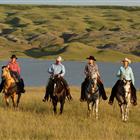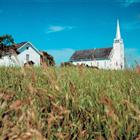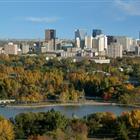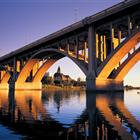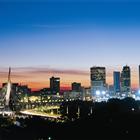
Browse
The Mennonite Heritage Village, adjacent to Kinetic Park, depicts the lifestyles and customs of homestead settlers who form part of the city's history. The village features an original homestead, church and garden. The buildings include authentic antiques and artifacts, and may be booked for tours. The Mennonite Heritage Village season runs from the July long weekend to Labour Day Weekend. Hours of operation are from 2 to 7 PM on Fridays, Saturdays, Sundays & holidays. Visitors are invited for Faspa which is served each afternoon. During Frontier Days, the village is open from 12 noon to 8 PM and features traditional Mennonite suppers served each evening. Annual events include the Watermelon Festival in mid July and the Fall Wind-up in September.
The Great Southwest, with its wide open spaces and living skies, is a place that must be experienced to be understood. It is enduring and authentic, providing visitors with a truly western experience. Historical sites across the region will take you back to Chief Sitting Bull, the forming of the North West Mounted Police and the building of Fort Walsh, but that is only part of the story, because the history of this area goes back ten thousand years, and each visit presents you with a new adventure.
The Big Muddy Badlands are an amazing spectacle of nature's architecture that conjures up images of the province's "wild-west" history. Observing the rugged hills, majestic plateaus of the area, it's easy to imagine silhouettes of cowboys and outlaws on the horizon.
In the heart of Big Muddy, you'll find Castle Butte. A relic from the ice age, this free standing structure with a circumference of 0.5km and an elevation of 60m, was a landmark to the First Nations people, the NWMP and early Canadian settlers. Evidence of early civilization can be found in the Big Muddy area in the form of stone effigies, ceremonial circles and ancient buffalo jumps.
Moose Jaw is the largest city in the region and it will captivate you with its historical, yet contemporary charm. This bustling city is home to tunnels that were rumoured to be the hideaway of the infamous Al Capone in the days of Prohibition. Tour the award-winning tunnels and learn the tricks of the boot-legging trade. After a long day of shopping and adventure, enjoy yourself by booking a treatment at the renowned Temple Gardens Mineral Spa, or try your luck at Casino Moose Jaw.
Among the most popular destinations in the area is Cypress Hills Interprovincial Park, an oasis in the midst of the open prairie that surrounds it. It is the highest point of land in Canada between the Rocky Mountains and Labrador. The park is home to rare wild flowers, towering stands of lodgepole pine and 200 species of birds and mammals that include moose, elk, deer and antelope.
A giant plateau that was once surrounded by glaciers, Cypress Hills attracts 250,000 people each year, yet it is still one of the best kept secrets in Canada. With its high forested hills, it provides visitors with panoramic views that allow you to see 100 miles in any direction.
Maple Creek, situated just north of Cypress HIlls Interprovincial Park, is the town where past is present. Also known as the original Cow-Town, Maple Creek boast rodeos and historic museums depicting the the lives of cowboys both past and present.
Eastend, located at the east end of the Cypress Hills, is the home of Wallace Stegner, a Pulitzer prize winning writer who described the prairie landscape as "a distance without limits." Like so many places in this area, it is just one of the treasures you will find when you explore Dino Country.
Dig a little deeper and you will learn about the first trading company in the Southwest. This is a story that goes back to 1873, but in the space of time, it's only a brief period of its history. The area has drawn international attention with the discovery of a near-complete Tyrannosaurus rex skeleton. "Scotty" is one of only about a dozen in the world, and is the feature exhibit at the T. rex Discovery Centre.
Grasslands National Park preserves a wide expanse of the broad Frenchman River Valley with its weathered badlands, untouched native prairie, and grassland flora and fauna. The park is home to the plains bison and is the only one of our 39 national parks that represents Prairie Grasslands. It is also the only place in Canada where colonies of black-tailed prairie dogs still exist. Along with bison and prairie dogs, you will find a unique blend of common and endangered species including the pronghorn antelope, sage grouse, burrowing owl, ferruginous hawk, short horned lizard and the prairie rattlesnake.
The park plays a major role in promoting habitat restoration and species preservation, and has been preserved through the joint efforts of conservationists. Waterways such as the Frenchman River add to the diversity and are important habitats. Unique combinations of landscape and climate create niches for specific plants and animals, and illustrate the character of this ecosystem. You'll find flora such as blue grama grass, a favourite with bison, prickly pear cactus, which only breathes at night; and gumbo evening primrose, whose flowers change colour in 24 hours.
The expansive valley with its coulees and buttes provides an impressive view characterized by layers of Bearpaw, Eastend, Whitemud, Frenchman and Ravenscrag formations. This exposed sedimentary rock opens a window to the extinction of the dinosaurs, and led to the first recorded find of dinosaur remains in Western Canada by Sir George Mercer Dawson back in 1874.
Leader is a "Gateway to the Unexpected" and part of the reason is the Great Sandhills, one of the largest set of active sand dunes in the country. The Sandhills are the area's main attraction, and draws visitors from across the country. Legends and secrets about the dunes can be uncovered by visiting the Great Sandhills Museum in Sceptre.
The view from the top of the Great Sandhills is breathtaking. The largest sand dunes are 25 meters in height and cover several hectares of land. The sand dunes are fringed by small clumps of trees such as aspen, birch, and willow, and by rose bushes, chokecherry and sagebrush. Native prairie grasses help to bind the sand together.
The Great Sandhills lie in the chinook area and are subject to strong winds blowing from the northwest. As a result, the exposed sand dunes are estimated to be moving east at a rate of about four meters per year. This creates an ever-changing landscape. Visiting this area is an experience unlike any other and worth every part of the trip.
Sask Landing is adjacent to the Coteau Hills, which offers rugged hills, wooded valleys and winding trails. Areas to explore include Lookout Point, Coulee Trail and the historic Battleford Trail. This area is known for its cattle ranching, and La Reata Ranch, which attracts visitors from across the world. Sask Landing is also the site of historic Goodwin House. This landmark building was a stagecoach station back in 1900 and served as a dispatch for nine years by the North West Mounted Police. The building has been completely restored and operates today as a visitors' centre.
Source: City of Swift Current, Southwest Tourism, Sask Tourism and Parks Canada


